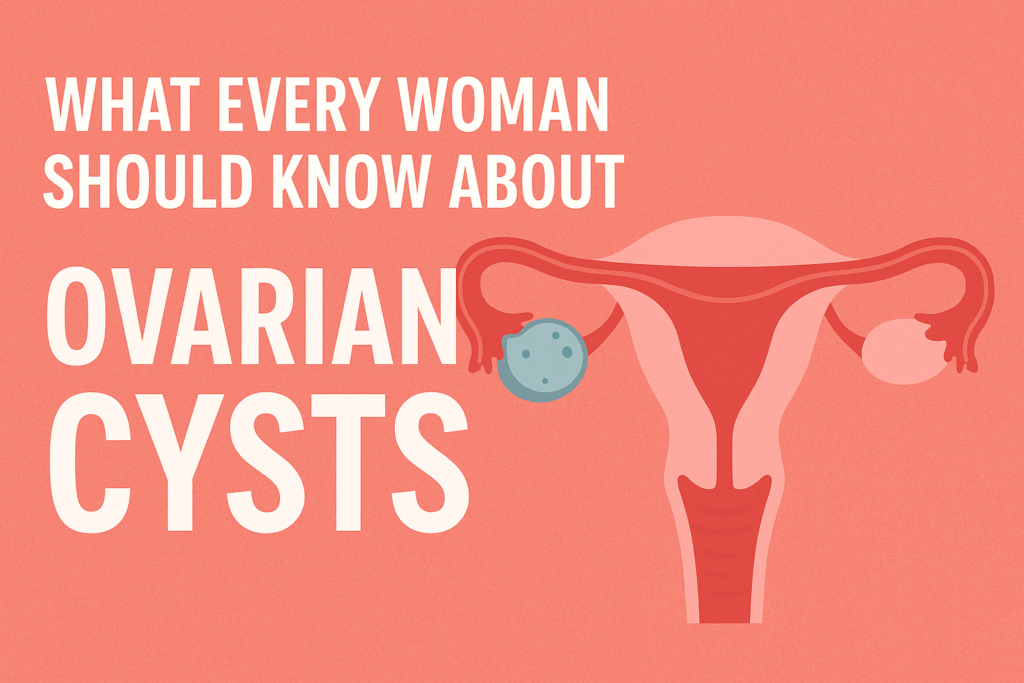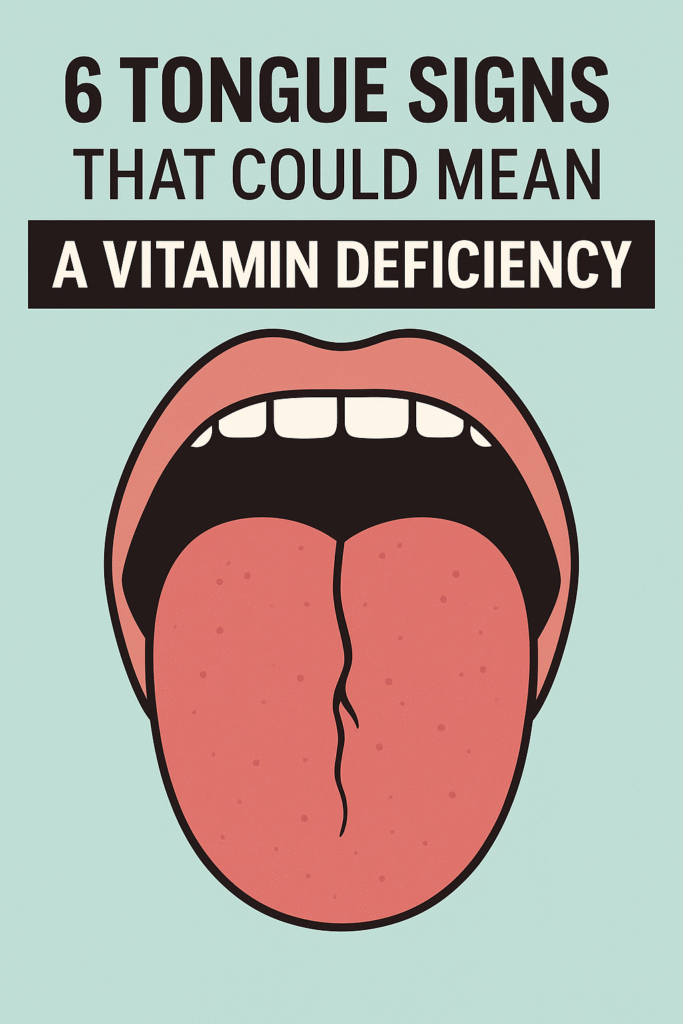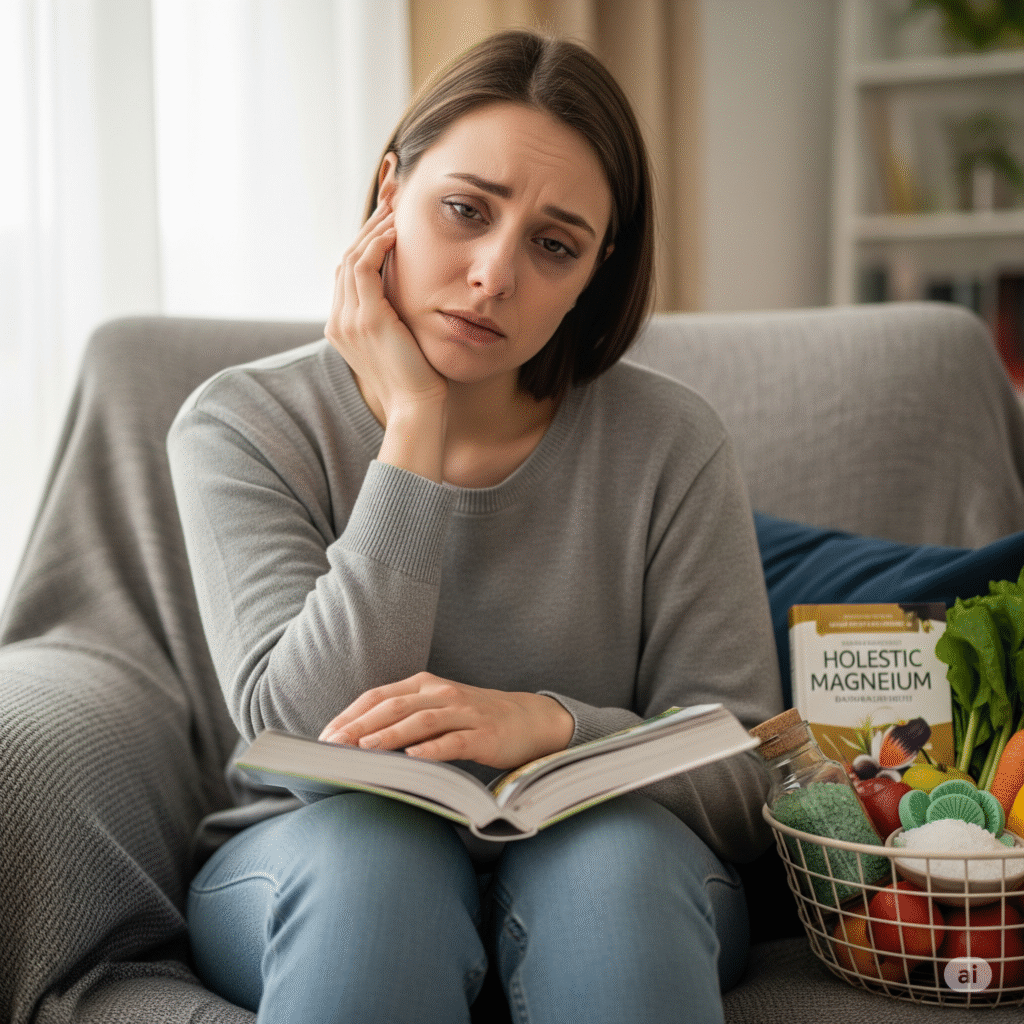
⚠️ Affiliate Disclaimer: This post may contain affiliate links, which means I may earn a small commission — at no extra cost to you — if you make a purchase through one of these links. I only recommend products or services I genuinely trust and believe can provide value. Thank you for supporting My Medical Muse!
10 Essential Facts Every Woman Must Know About Ovarian Cysts
What Every Woman Should Know About Ovarian Cysts
Ovarian cysts are one of the most common gynecological conditions that women may encounter during their lifetime. These fluid-filled sacs, which develop in or on the ovaries, often go unnoticed because they typically cause no symptoms and resolve naturally without treatment. For many women, ovarian cysts are a temporary and harmless occurrence, discovered only during routine checkups or imaging for unrelated concerns.
However, not all cysts are benign or symptom-free. Some may cause discomfort, disrupt menstrual cycles, or lead to complications such as rupture or ovarian torsion. In certain cases, persistent or complex cysts may also signal underlying health conditions like endometriosis, polycystic ovary syndrome (PCOS), or, rarely, ovarian cancer, because of this, awareness and timely medical evaluation are essential.
Understanding ovarian cysts goes beyond simply knowing they exist. It involves learning about:
- What ovarian cysts are and why they form
- Different types of cysts and their risk factors
- The symptoms women should watch for
- Methods of diagnosis and available treatment options
- Potential impacts on fertility and overall health
- Preventive measures and lifestyle adjustments that support reproductive wellness
By exploring these areas in depth, women can feel more informed, empowered, and proactive about their reproductive health. This knowledge not only reduces anxiety around the diagnosis of ovarian cysts but also encourages early intervention when necessary, ultimately leading to better outcomes.
In the sections that follow, we’ll take a closer look at everything every woman should know about ovarian cysts from causes and symptoms to treatment and prevention offering both medical insights and practical advice for daily living
Understanding Ovarian Cysts
What Are Ovarian Cysts?
An ovarian cyst is a fluid-filled sac that develops in or on one of the ovaries. The ovaries are two small, almond-shaped reproductive organs located on either side of the uterus. They play an essential role in the female reproductive system, producing eggs (ova) for fertilization as well as hormones such as estrogen and progesterone that regulate the menstrual cycle.
Ovarian cysts can vary widely in size. Some are tiny, like a pea, and cause no noticeable symptoms, while others may grow as large as an orange, creating pressure or discomfort in the pelvic area. In the majority of cases, ovarian cysts are benign (non-cancerous) and resolve naturally without medical treatment. However, in some instances, cysts may persist, grow, or lead to complications, requiring medical attention.
Types of Ovarian Cysts
There are several types of ovarian cysts, each with distinct causes and characteristics. Understanding these types is important for recognizing their impact on women’s health:
- Functional Cysts
These are the most common type, directly related to the menstrual cycle.- Follicular cysts: Form when a follicle (the sac that normally holds and releases an egg) fails to release the egg and continues to grow.
- Corpus luteum cysts: Develop when the follicle successfully releases an egg but does not dissolve afterward. Instead, it reseals and fills with fluid or blood.
- Follicular cysts: Form when a follicle (the sac that normally holds and releases an egg) fails to release the egg and continues to grow.
- Dermoid Cysts (Teratomas)
These unusual cysts contain tissues such as hair, skin, or even teeth. They develop from embryonic cells and, though typically benign, can sometimes grow large enough to cause discomfort or complications. - Cystadenomas
These cysts grow from the surface of the ovary and may contain a watery or mucous-like fluid. While usually benign, they can become quite large and exert pressure on nearby organs. - Endometriomas
Caused by endometriosis, these cysts form when tissue similar to the uterine lining attaches to the ovaries. They can be painful, particularly during menstruation or intercourse, and may impact fertility. - Polycystic Ovaries (PCOS)
In women with polycystic ovary syndrome (PCOS), multiple small cysts often develop on the ovaries as a result of hormonal imbalances. PCOS is associated with irregular periods, infertility, acne, and metabolic issues such as insulin resistance.
Are Ovarian Cysts Common?
Yes, ovarian cysts are extremely common, especially among women of reproductive age. In fact, most women will develop at least one ovarian cyst during their lifetime, often without even realizing it. These cysts are frequently discovered incidentally during routine pelvic exams or ultrasounds performed for unrelated reasons.
The reassuring truth is that the vast majority of cysts are harmless and temporary, because some can cause complications, it’s important for women to be aware of their bodies, track symptoms, and attend regular gynecological checkups.
Causes of Ovarian Cysts
Understanding the causes of ovarian cysts helps women identify potential risk factors and adopt preventive strategies when possible. While some cysts occur naturally as part of the menstrual cycle, others may result from underlying conditions.
Hormonal Imbalances
Hormonal fluctuations are one of the leading causes of ovarian cyst formation. Since ovulation depends heavily on hormonal regulation, imbalances may disrupt this process. For instance, if a follicle fails to release an egg due to irregular hormone signals, a follicular cyst can form.
Women undergoing fertility treatments that stimulate ovulation are more likely to develop functional cysts. Similarly, women with irregular menstrual cycles are at greater risk, since inconsistent ovulation often creates opportunities for cysts to develop.
Pregnancy
Ovarian cysts can also occur during pregnancy. In early pregnancy, the corpus luteum cyst often forms naturally to support the pregnancy until the placenta takes over hormone production. While these cysts are usually harmless, doctors monitor them to ensure they don’t grow excessively or cause complications.
Endometriosis
Endometriosis is a condition where tissue similar to the uterine lining grows outside the uterus. When this tissue attaches to an ovary, it can form an endometrioma. These cysts can be painful, especially during menstruation, and are strongly linked to infertility in some women.
Severe Pelvic Infections
Infections of the reproductive organs, particularly if untreated, can spread to the ovaries and fallopian tubes. When this happens, they may cause cyst-like abscesses to form. These infections not only create painful cysts but also carry long-term risks for reproductive health.
Family History & Genetics
Some types of ovarian cysts may have a genetic component. For example, dermoid cysts and conditions like PCOS often run in families, suggesting a hereditary predisposition. Women with a family history of ovarian or reproductive disorders may be at higher risk of developing cysts and should be proactive about regular screening.
Symptoms of Ovarian Cysts
Not all ovarian cysts produce noticeable symptoms. In fact, many women may live with them without ever knowing, as they often resolve on their own. However, when symptoms do occur, they can range from mild discomfort to sudden, severe pain requiring urgent medical care.
Common Symptoms
The most frequent symptoms associated with ovarian cysts include:
- Pelvic pain: This may feel sharp, dull, or intermittent, often localized on the side of the cyst.
- Abdominal bloating or swelling: A sensation of fullness or heaviness in the abdomen.
- Pain during intercourse: Discomfort or pain during or after sexual activity.
- Painful bowel movements or bladder pressure: Larger cysts may press on nearby organs, causing constipation, frequent urination, or pain.
- Menstrual irregularities: This can include unusually heavy or light periods, missed cycles, or irregular bleeding.
- Lower back or thigh pain: Aching discomfort that radiates beyond the pelvic area.
Emergency Symptoms (Seek Immediate Medical Help)
In rare cases, cysts may rupture or twist (a condition called torsion), leading to serious complications. Emergency medical attention is required if you experience:
- Sudden, severe abdominal or pelvic pain
- Fever, nausea, or vomiting
- Rapid breathing, dizziness, or fainting which may indicate internal bleeding or shock
These symptoms should never be ignored, as they may signal a ruptured cyst or ovarian torsion, both of which require urgent medical care.
Diagnosis of Ovarian Cysts
Because many cysts are symptom-free, they are often discovered during routine gynecological exams or imaging tests for unrelated issues. Accurate diagnosis helps determine whether a cyst is harmless or requires treatment.
Physical Exam
During a pelvic exam, a doctor may feel swelling or abnormal growths near the ovaries. While this alone cannot confirm a cyst, it often prompts further testing.
Imaging Tests
- Ultrasound: The most common and reliable method for diagnosing ovarian cysts. It uses sound waves to create images of the ovaries, helping determine the size, type, and location of the cyst.
- CT Scan or MRI: These advanced imaging tools provide more detailed information if the ultrasound results are unclear or if a more complex cyst is suspected.
Blood Tests
- CA-125 Test: Measures a protein that can be elevated in ovarian cancer. While not a definitive test, it is sometimes used in postmenopausal women or when cysts look suspicious on imaging.
- Hormonal tests: Check for imbalances related to conditions like PCOS or thyroid disorders that may contribute to cyst formation.
Laparoscopy
In cases where diagnosis remains uncertain or when a cyst requires removal, doctors may perform a laparoscopy. This minimally invasive procedure involves inserting a thin camera through a small incision in the abdomen to directly view the ovaries and, if needed, remove the cyst for biopsy.
Chapter 5: Treatment Options
The best treatment depends on the size, type, symptoms, and age of the patient, as well as whether she is pre- or postmenopausal. While many ovarian cysts disappear without treatment, others require medical or surgical management.
1.Watchful Waiting
For small, functional cysts with no concerning symptoms, doctors may recommend a “wait and see” approach. This involves monitoring the cyst with follow-up ultrasounds over a few months to check if it resolves naturally.
2. Medications
- Hormonal birth control pills: These can help regulate the menstrual cycle and reduce the likelihood of new cyst formation. However, they do not shrink existing cysts.
- Pain relievers: Over the counter or prescribed pain medications may be used to manage discomfort until the cyst resolves.
3. Surgical Options
When cysts are large, persistent, or suspicious for cancer, surgery may be necessary:
- Laparoscopy: A minimally invasive procedure best for smaller cysts. Surgeons remove the cyst through tiny incisions with the aid of a camera.
- Laparotomy: An open surgical approach used for larger cysts or when malignancy is suspected.
- Oophorectomy: In severe cases, the entire ovary may need to be removed, especially if the cyst is cancerous or if there are recurrent issues.
Alternative & Supportive Care
While these approaches do not cure cysts, they may help manage symptoms and improve quality of life:
- Heat therapy: Using a heating pad or warm compress can ease pelvic pain and cramping.
- Dietary adjustments: Eating an anti-inflammatory diet rich in whole foods, lean proteins, and omega-3 fatty acids may support hormonal balance.
- Stress management: Practices like yoga, meditation, or deep breathing can reduce hormonal fluctuations that may contribute to cyst formation.
Ovarian Cysts and Fertility
Ovarian cysts can affect fertility in different ways, depending on their type, size, and underlying cause. While some cysts are harmless, others may interfere with ovulation, hormone balance, or the health of reproductive organs.
Do Ovarian Cysts Affect Fertility?
- Functional cysts: These are common and typically harmless. Since they form naturally during the menstrual cycle, they rarely affect fertility and usually resolve on their own.
- Endometriomas: Caused by endometriosis, these cysts can damage ovarian tissue, reduce egg quality, and make conception more difficult.
- PCOS-related cysts: Women with polycystic ovary syndrome (PCOS) often experience irregular ovulation or no ovulation at all, which can make getting pregnant challenging.
- Large or multiple cysts: In some cases, cysts that grow too large or appear in clusters may physically disrupt ovulation or interfere with nearby reproductive structures.
Treatment and Fertility Preservation
Fortunately, many women with ovarian cysts can still achieve pregnancy with the right treatment and medical support:
- Fertility-preserving surgeries: Procedures like laparoscopic cyst removal aim to eliminate cysts while protecting healthy ovarian tissue.
- Assisted reproductive technologies (ART): Options such as in vitro fertilization (IVF) can help women who struggle with fertility due to cyst-related conditions.
- Hormonal regulation: Birth control or fertility drugs may be prescribed to balance hormones, encourage regular ovulation, and improve chances of conception.
For women planning a family, early consultation with a gynecologist or fertility specialist is essential to create a personalized treatment plan.
Complications of Ovarian Cysts
Most ovarian cysts are harmless, but complications can arise in certain cases. Awareness of these potential risks helps women seek timely medical attention.
- Rupture: When a cyst bursts, it can cause sudden, intense pelvic pain and sometimes internal bleeding. Depending on severity, this may require emergency care.
- Ovarian torsion: If a cyst grows large, it can cause the ovary to twist, cutting off its blood supply. This is a medical emergency that requires immediate surgery to save the ovary.
- Cancerous growths: Although rare, especially in premenopausal women, some ovarian cysts can be malignant. Risk increases with age, particularly after menopause.
Prompt medical evaluation of unusual or persistent cysts can significantly reduce the risks of severe complications.
Living with Ovarian Cysts
For many women, ovarian cysts are a recurring part of life. While they may not always require treatment, managing symptoms and maintaining overall reproductive health are key to living well with the condition.
Lifestyle & Self-Care
Adopting healthy lifestyle habits can support hormonal balance, reduce discomfort, and promote overall well-being:
- Eat a balanced diet: Focus on whole foods, fruits, vegetables, whole grains, and lean proteins to reduce inflammation and support hormone regulation.
- Stay active: Regular physical activity improves circulation, reduces stress, and helps maintain a healthy weight, all of which contribute to reproductive health.
- Manage stress: Chronic stress can disrupt hormonal balance. Mindfulness practices like yoga, meditation, or journaling can help keep stress levels in check.
When to See a Doctor
It’s important not to ignore symptoms that could indicate complications. Schedule a medical appointment if you experience:
- Persistent or worsening pelvic pain
- Unexplained changes in menstrual cycles
- Difficulty conceiving after trying for several months
- Sudden, severe pain or other emergency symptoms
Prevention and Awareness
While not all ovarian cysts can be prevented, proactive steps can lower risks and ensure early detection of potential issues.
- Regular pelvic exams: Routine gynecological checkups help detect cysts early, even when symptoms are absent.
- Use of birth control pills: For some women, hormonal contraceptives can regulate ovulation and reduce the risk of new cyst formation.
- Address underlying conditions: Managing conditions like PCOS or endometriosis can minimize cyst-related complications.
- Maintain a healthy lifestyle: A balanced diet, exercise, and stress management support overall reproductive health and may reduce cyst recurrence.
Myths and Facts About Ovarian Cysts
Misinformation about ovarian cysts often causes unnecessary fear or confusion. By separating myths from facts, women can make informed decisions about their health and approach the condition with greater confidence.
Myth: All ovarian cysts are cancerous.
- Fact: The vast majority of ovarian cysts are benign (non-cancerous). Malignant cysts are rare and occur more often in postmenopausal women.
Myth: Ovarian cysts only affect older women.
- Fact: Ovarian cysts can develop at any age, from adolescence through menopause. In fact, they are most common during a woman’s reproductive years.
Myth: Surgery is always required.
- Fact: Most cysts disappear on their own without medical intervention. Surgery is only necessary for large, persistent, painful, or suspicious cysts.
Myth: Ovarian cysts always cause symptoms.
- Fact: Many cysts are asymptomatic and discovered only during routine exams or imaging for unrelated reasons.
Myth: Ovarian cysts mean infertility.
- Fact: While certain types (such as endometriomas and PCOS-related cysts) can affect fertility, many cysts have no impact on a woman’s ability to conceive.
Conclusion
Ovarian cysts are a common and often harmless condition, experienced by countless women throughout their lives. While many cysts cause no symptoms and resolve on their own, some may lead to discomfort, complications, or indicate underlying health concerns.
By learning about the different types of cysts, understanding their causes and symptoms, and being aware of diagnosis and treatment options, women can take an active role in protecting their reproductive health. Simple steps such as regular pelvic exams, healthy lifestyle choices, and timely medical consultations can make a significant difference in early detection and management.
Most importantly, awareness leads to empowerment. Every woman should feel confident discussing ovarian cysts with her healthcare provider, asking questions, and seeking treatment when necessary. With the right knowledge and support, women can navigate ovarian cysts with resilience, safeguard their fertility, and maintain overall well-being.
👩⚕️ Need Personalized Health Advice?
Get expert guidance tailored to your unique health concerns through MuseCare Consult. Our licensed doctors are here to help you understand your symptoms, medications, and lab results—confidentially and affordably.
👉 Book a MuseCare Consult NowRelate Blog Post You Might Like:
- 15 Powerful Hormonal Imbalance Remedies for Women Over 40
- Migraines in Women: 10 Powerful Reasons They’re 3x More Common Than Men
- Managing Stress During IVF: 10 Powerful Tips for Emotional Well-being
- 10 Powerful Tips on How to Choose the Right Fertility Clinic
- Understanding the Impact of Age on Female Fertility: 9 Powerful Facts
- 7 Powerful Insights on Osteoporosis in Women Under 50


